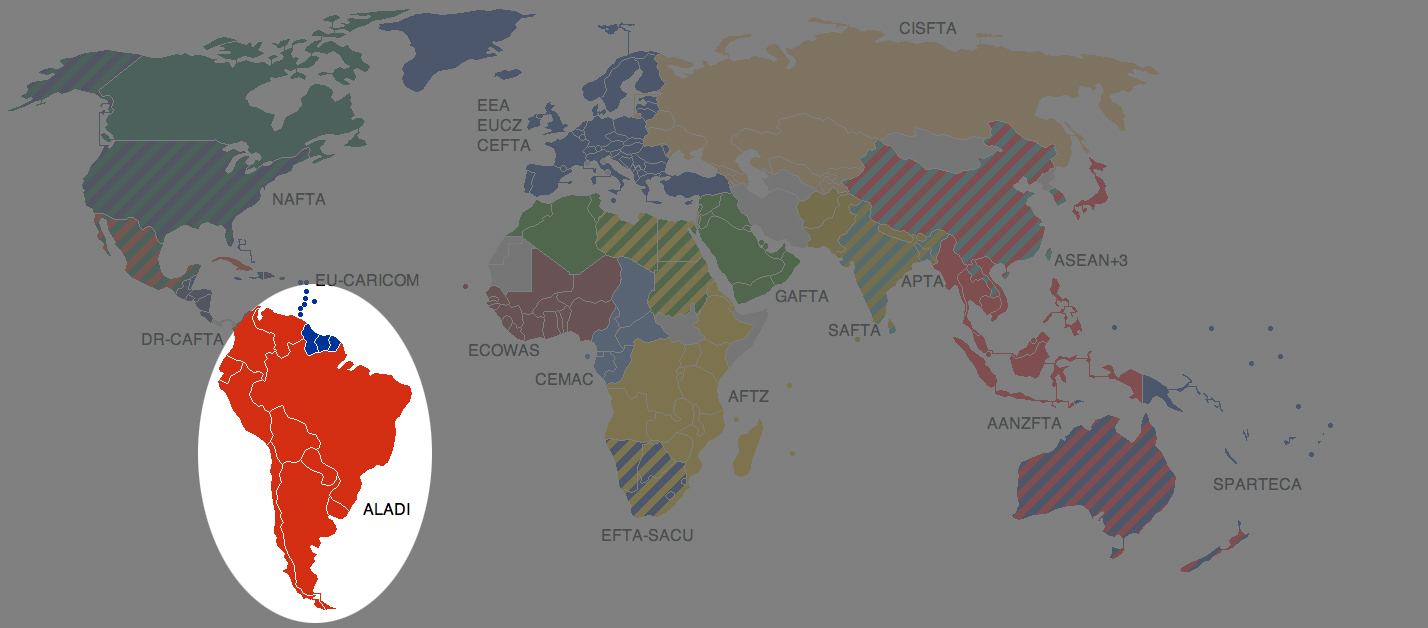
Where trade agreements such as NAFTA
and CARICOM seek to strengthen free trade ties between countries of a
shared region - NAFTA for North America and CARICOM for the
Caribbean - so the ALADI agreement seeks to meet this goal for much
of South American. With its roots in the Treaty of Montevideo in
1980, the nation members of ALADI (Asociación
Latinoamericana de Integración,
or Latin American Integration Association) work together to foster
the success of the Latin American common market while forging
positive relationships with similar unions throughout the world.
As
the largest economic association on the continent, ALADI is comprised
of twelve primary nation members:
Argentina - Largely agricultural
in terms of global trade, Argentina exports soy products and grains
to their major trade partners, including ALADI nations Brazil and
Chile.
Bolivia - Much of Bolivia's
export product comes from the mining industry. Here one will find
one of the largest lithium deposits in the world, as well as natural
gas reserves.
Brazil - One of the richer
nations in this free trade zone, Brazil is known for their
production of machinery and transportation equipment. Agriculture,
however, remains vital to the economy through their production of
coffee and soy.
Chile - Copper mining is an
important industry here; much of the world became familiar with
Chile by way of the courageous rescue of 33 miners trapped in a mine
collapse in 2010.
Colombia - Colombia is one of
the world's top producers of nickel, coffee, and natural fuels. Of
the ALADI nations, Colombia exports the majority of goods to
Venezuela.
Cuba - While not a South
American nation, Cuba was accepted into the agreement in 1999 by
virtue of their association with Latin America.
Ecuador - A country of diverse
economic stature, Ecuador relies upon mainly agricultural exports
like bananas and shrimp for trade with the United States.
Mexico - Mexico benefits greatly
in trade through this treaty and NAFTA. Silver is a primary export,
along with food and livestock, particularly brands popular in the
US.
Paraguay - The majority of
Paraguay's export trade is done within the continent, with
soybeans and cotton among their more popular cash crops.
Peru - Precious metals are
sought-after commodities from main trade partners China, Canada, and
the US. Copper, zinc, and gold mines keep a good percentage of the
labor force at work.
Uruguay - Nearly forty percent
of the country's export product is beef. Dairy also accounts for a
significant amount of export income.
Venezuela - Unlike her more
agricultural neighbors, Venezuela generates revenues mainly through
exporting natural gases and chemicals.
The trade agreement established between
the ALADI nations is designed to promote exchange of goods and
services across open borders, with preferential treatment given to
the less developed member nations as a means of compensating for what
they lack to compete with the larger economies on a global scale.
Countries within the agreement are obliged to grant each other
reductions in tariffs as they might with non-members, while ALADI
also works to strength these relations with non-member Latin American
countries and beyond. With ALADI's additional participation
in bi-lateral trade agreements - mainly with North America and Asia
- the less developed nations of South America have the opportunity
to expand their reach. Eventually, one may find ALADI absorbed by
similar organizations like MERCOSUR (the Common Southern Market) and
the Adean Community of Nations, both of which are designed to
establish a common Union of South American Nations, or UNASUR, to
resemble the EU model. Whatever the future holds for ALADI, its
place in the South American economy has left an indelible mark.